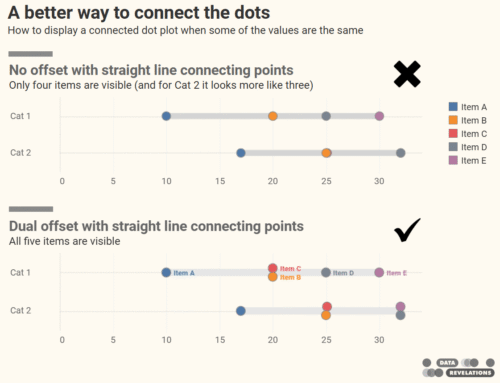Overview
In my experience the number one impediment to success with Tableau is getting data in a format that plays nicely with Tableau. Alteryx is a combination ETL (extract, transform, load), geospatial, and statistical modeling solution that just may solve this “getting-the-data-right” problem.
And it plays very nicely with Tableau.
In this blog I will recount some experiences I’ve had with Alteryx and some thoughts on what the future might hold for the two companies.
Client One
In April of 2013 I was working with one of my favorite clients and we ran into a roadblock in that they needed to blend a lot of data from disparate sources and this confluence of data was an absolute monstrosity. I was on the precipice of recommending that they hire a data warehousing consultant when I happened to attend a Tableau road show in New York City. Alteryx sponsored the lunch that day and I paid attention to their presentation.
Fast-forwarding a bit, I received a very compelling demo and product roadmap from Dean Stoecker, Alteryx’s CEO.
I visited my client the next day and told them to hold off on hiring the consultant and look into Alteryx as a better short, mid, and long term solution. It proved to be a good recommendation as the client is now blending data from a lot of sources and gleaning insights that would have taken much longer had we gone the consultant /consolidated warehouse route.
Client Two
About six months ago I was working with another client that was swimming in data, but that data was missing some key elements. The client was tracking hundreds of service calls throughout the New York metropolitan area and although they had street addresses for every incident they were only able to produce a map that showed results at the county level, and this didn’t reveal very much.
I asked them to look into seeing if the incidents clustered in particular neighborhoods. For this we would need latitude and longitude coordinates for each street address.
Six weeks later the client triumphantly called and told me their IT department had finally added zip code information to the database query they used to drive the visualization. I sighed and politely told them that while having zip code-level data was better than county-level data, zip codes would not give us the granularity we needed.
At this point I asked them to send me a copy of the data and, armed with Alteryx and the Tom Tom US maps, I generated latitude and longitude for 99% of the addresses.
And I did this in about 15 minutes.
The next day I presented the client with a symbol map that contained a different color-coded circle for every incident in the database. I wish I could tell you that we discovered something truly amazing once we had this (we didn’t) but the critical point is that tools like Alteryx and Tableau allowed us to pursue a hunch in a matter of minutes. The next hunch might yield an incredible insight and with Alteryx and Tableau we can investigate these notions without having to tax an already over-burdened IT department.
Client Three – Me
Any followers of this blog know that I do a lot of work with survey data and to get Tableau to do what it does so well survey data as downloaded from a survey tool needs to be parsed, pummeled, and browbeaten into submission.
For years I’ve been using either Tableau’s free Excel add-in (when the data is in that format) or relying on the kindness of DBAs to render the data in the format I need.
The problem with the Excel approach is that it requires a lot of hand manipulation and if the client decides they want to include responses after they have sworn the survey is closed, well, I end up having to go through the whole error-prone process a second or third time.
Enter Alteryx, which allows me to set up the process once, automate it, and then run it whenever I need. The icing on the cake is that it generates a ready-to-use Tableau .TDE file. In addition to the process being faster and safer, I can start visualizing survey data way before the survey is closed. This has been a huge time saver for me and I will never go back to hand-massaging the data. Plus, if the data source is a database (vs. downloaded files) I can apply the same tool and the same process without needing the DBA to fashion anything special for me.
Will Tableau Acquire Alteryx?
Given that Alteryx fills a gap that currently exists with Tableau and that the two products play so nicely together, in September 2013 I predicted that within a year Tableau would acquire Alteryx.
So I was wrong. But will it happen down the road? I do like how the two tools work together but there are some things about Alteryx that Tableau users may find off-putting, including:
Alteryx is a “heavy lunch”
Alteryx is an ETL, geospatial, predictive modeling, breath mint, candy mint, floor wax, all-in-one tool. This cornucopia of options can be intimidating.
Alteryx assumes more knowledge
Alteryx assumes a greater level of programming sophistication than does Tableau. For example, Alteryx makes a distinction between equivalence and an assignment. In Alteryx you would write
X=7
To assign the value 7 to the variable X. But if you were performing a comparison in an IF statement you would write
IF X==7 Then [what to do] ENDIF
Tableau does not make the distinction between the single and double equal sign. Granted, if you attempt to use one equal sign in Alteryx you’ll get an error message with the suggestion that you should use the double equal sign, but there appears to be an assumption that the user comes into Alteryx with an appreciation for standard programming syntax.
It’s Easier to Break Things in Alteryx
If you change the name of a field in Tableau everything that refers to that field also changes. This is not the case with Alteryx and modifying your Alteryx module to address this field name change can be a pain.
Indeed, I think this example epitomizes the difference in refinement between the two tools. Don’t get me wrong, Alteryx is a terrific tool and I am very happy to have it in my quiver, but there is a higher degree of user affordance in Tableau, and users accustomed to Tableau’s luxury car feel may find Alteryx a bit of a bumpy ride.
So, while I don’t see Tableau acquiring the Alteryx and supporting the tool in its current form, who knows what will happen as both tools and companies mature?
So, Should You Buy Alteryx?
I can’t answer this question but you should at least download an evaluation copy and try it out. I will tell you that for my survey data practice the product has been a godsend.






